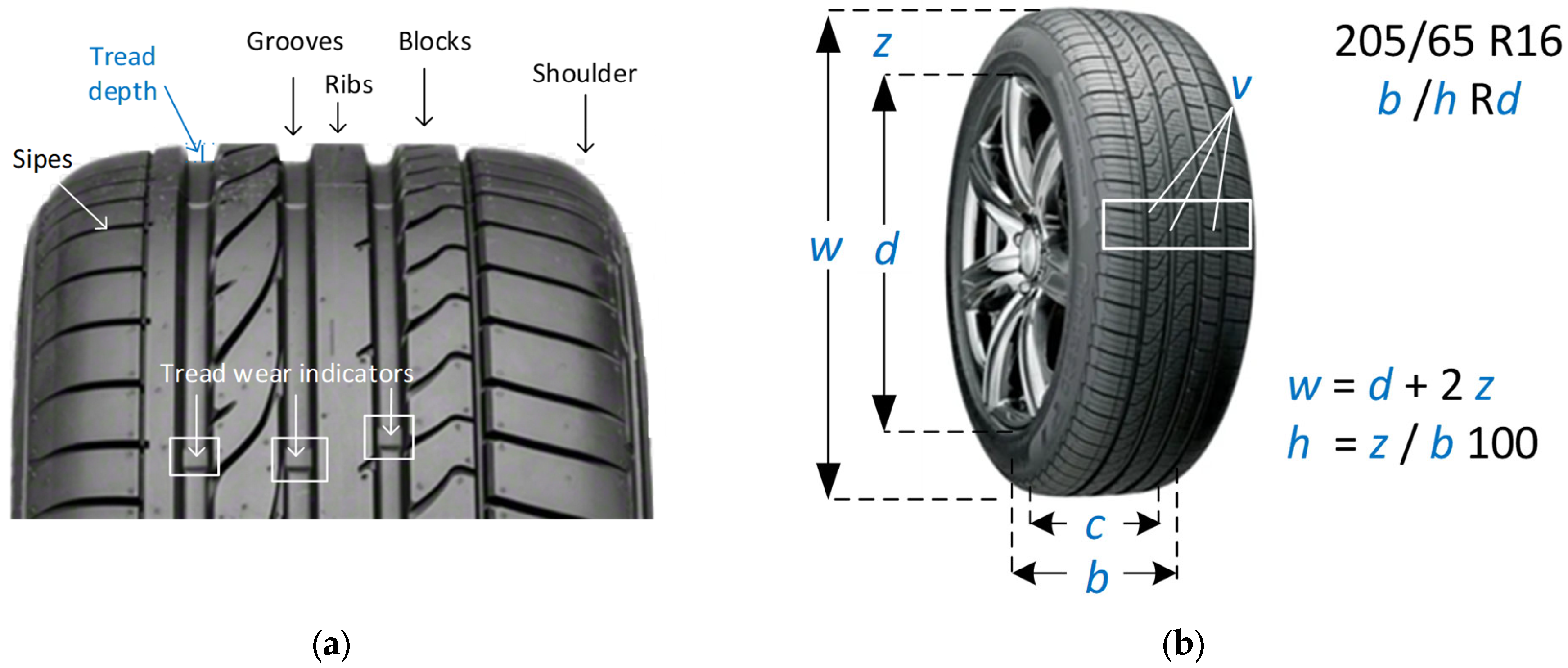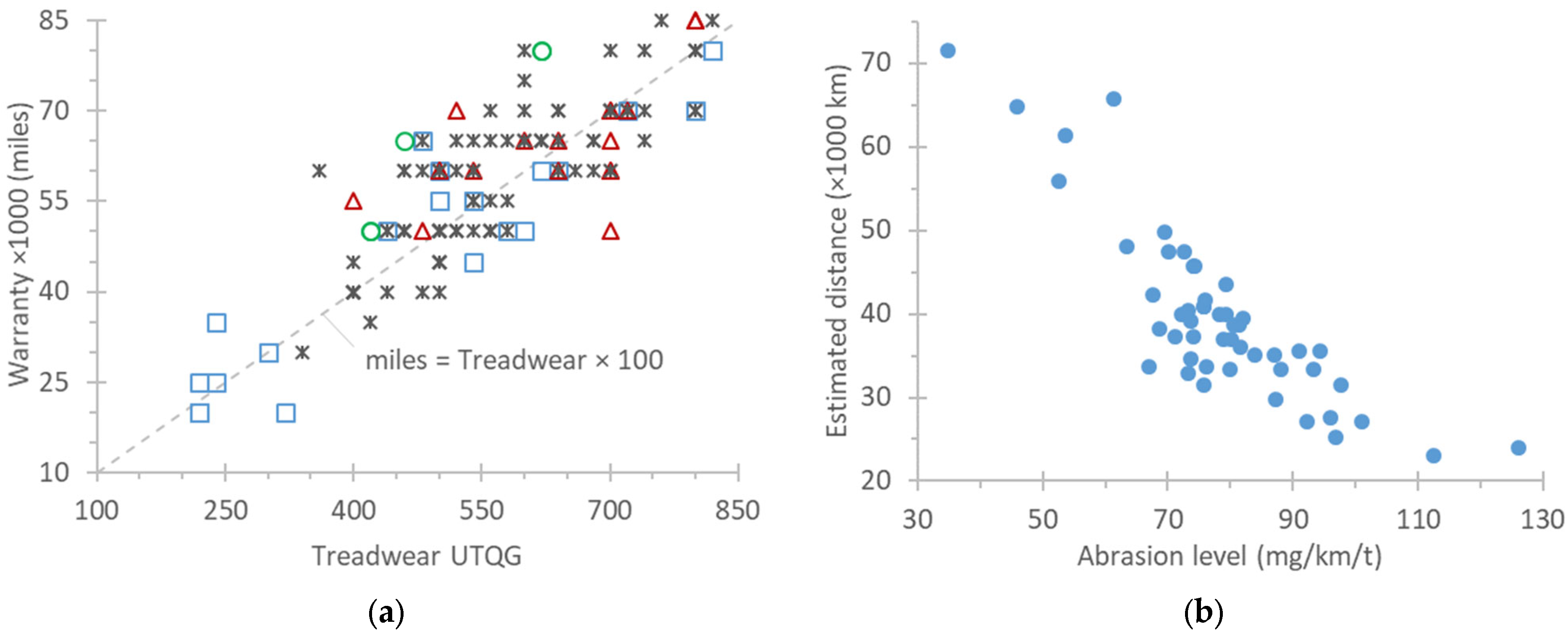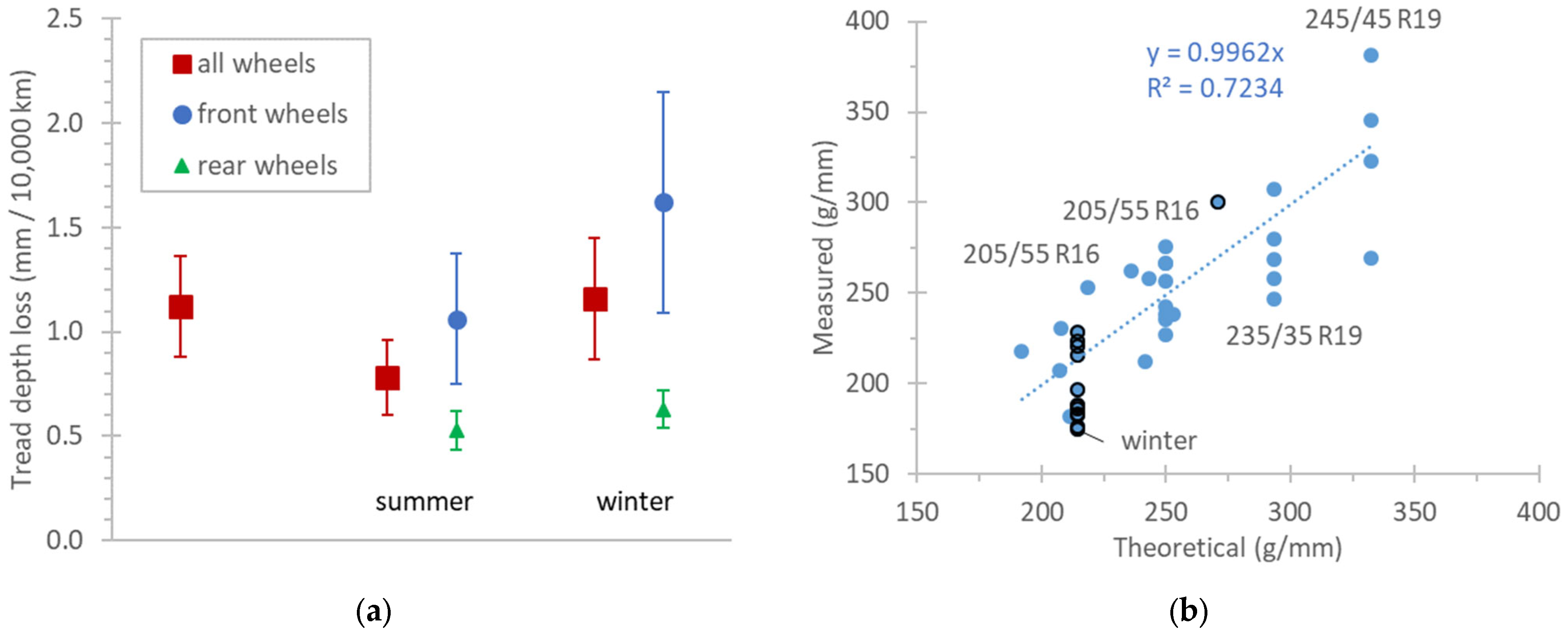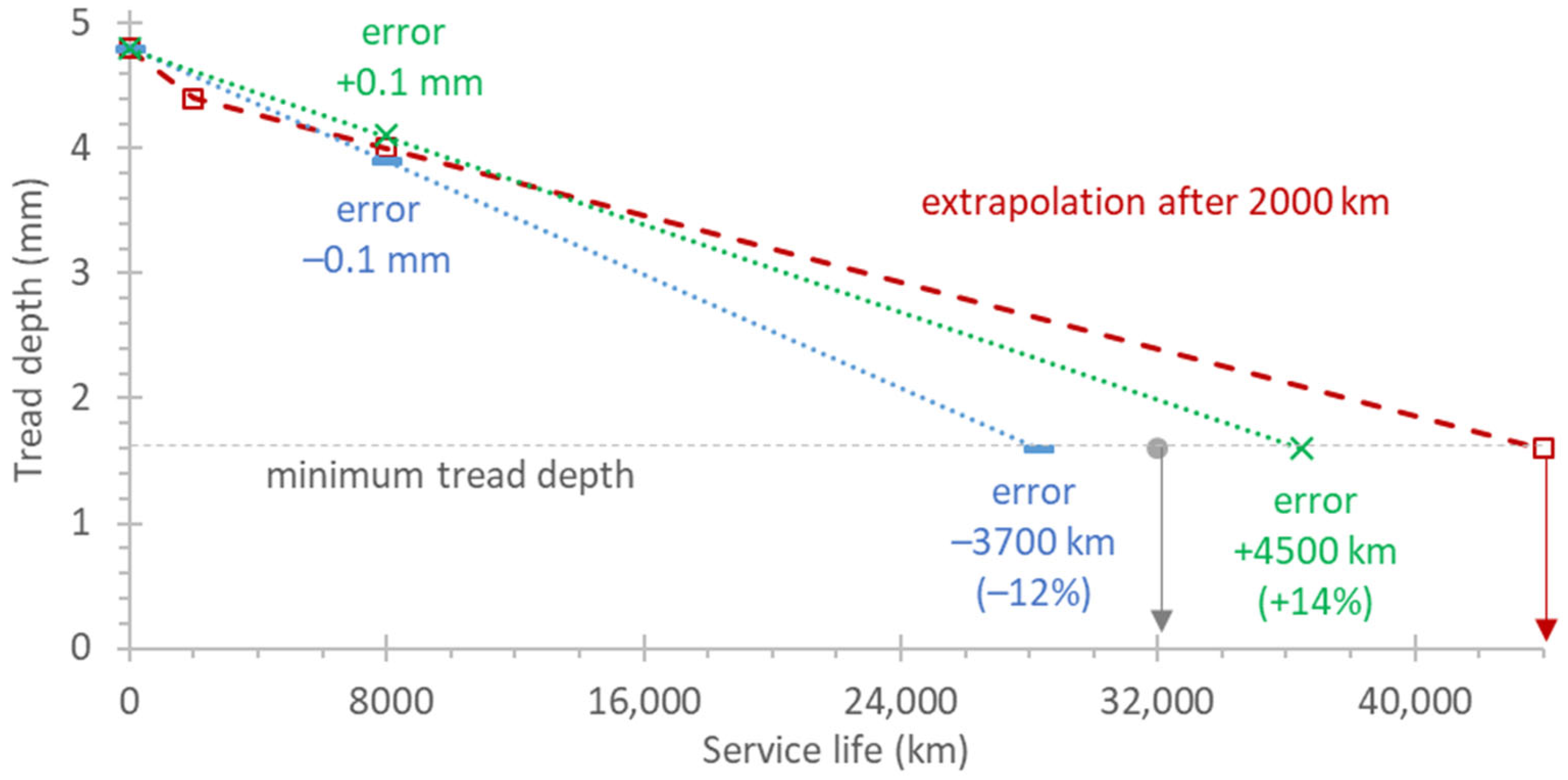Tire Wear, Tread Depth Reduction, and Service Life
Abstract
:1. Introduction
2. Background
2.1. The 19th Century
2.2. Uniform Tire Quality Grading (UTQG) for Tread Wear
2.3. Tire Labeling
3. Correlation Results
3.1. Tread Wear UTQG and Mileage Warranty
3.2. Tread Depth Reduction and Projected Service Life
3.3. Distance Traveled per mm Tread Depth Reduction
3.4. Mass Loss per mm of Tread Depth Reduction
4. Conclusions
Author Contributions
Funding
Data Availability Statement
Acknowledgments
Conflicts of Interest
Appendix A

References
- Rodgers, B. Tire Engineering: An Introduction; CRC Press: Boca Raton, FL, USA, 2020; ISBN 978-1-00-302296-1. [Google Scholar]
- Krishnappa, V.; Matthews, H.S.; Liu, Y. Data-Driven Analysis to Support Revised Tire Tread Inspection Standards. Transp. Res. Rec. 2019, 2673, 517–528. [Google Scholar] [CrossRef]
- Pomoni, M. Exploring Smart Tires as a Tool to Assist Safe Driving and Monitor Tire–Road Friction. Vehicles 2022, 4, 744–765. [Google Scholar] [CrossRef]
- Castañón, A.M.; Sanmiquel, L.; Bascompta, M.; Vega Y De La Fuente, A.; Contreras, V.; Gómez-Fernández, F. Used Tires as Fuel in Clinker Production: Economic and Environmental Implications. Sustainability 2021, 13, 10455. [Google Scholar] [CrossRef]
- Soprych, P.; Czerski, G.; Grzywacz, P. Studies on the Thermochemical Conversion of Waste Tyre Rubber—A Review. Energies 2023, 17, 14. [Google Scholar] [CrossRef]
- Giechaskiel, B.; Grigoratos, T.; Dilara, P.; Franco, V. Environmental and Health Benefits of Reducing Tyre Wear Emissions in Preparation for the New Euro 7 Standard. Sustainability 2024, 16, 10919. [Google Scholar] [CrossRef]
- Schütte, J.; Sextro, W. Tire Wear Reduction Based on an Extended Multibody Rear Axle Model. Vehicles 2021, 3, 233–256. [Google Scholar] [CrossRef]
- Löwer, J.; Wagner, P.; Unrau, H.-J.; Wies, B.; Gauterin, F. Model for the Pattern-Dependent Wet Grip Prediction of Tires. Vehicles 2021, 3, 84–110. [Google Scholar] [CrossRef]
- Ha, J.U.; Bae, S.H.; Choi, Y.J.; Lee, P.-C.; Jeoung, S.K.; Song, S.; Choi, C.; Lee, J.S.; Kim, J.; Han, I.S. Control of Tire Wear Particulate Matter Through Tire Tread Prescription. Polymers 2023, 15, 2795. [Google Scholar] [CrossRef]
- Iliopoulos, I.A.; Sakellariou, J.S. Remaining Useful Life Estimation of Hollow Worn Railway Vehicle Wheels via On-Board Random Vibration-Based Wheel Tread Depth Estimation. Sensors 2024, 24, 375. [Google Scholar] [CrossRef]
- Council Directive 89/459. On the Approximation of the Laws of the Member States Relating to the Tread Depth of Tyres of Certain Categories of Motor Vehicles and Their Trailers. Off. J. Eur. Union 1989, L226, 1. [Google Scholar]
- European Consumer Centres Network Winter Tires Within Europe, in Iceland and Norway. 2019. Available online: https://www.europe-consommateurs.eu/fileadmin/Media/PDF/publications/etudes_et_rapports/Etudes_EN/Winter_tires_within_Europe.pdf (accessed on 24 February 2025).
- Kunze, M.; Feißel, T.; Ivanov, V.; Bachmann, T.; Hesse, D.; Gramstat, S. Analysis of TRWP Particle Distribution in Urban and Suburban Landscapes, Connecting Real Road Measurements with Particle Distribution Simulation. Atmosphere 2022, 13, 1204. [Google Scholar] [CrossRef]
- Li, J.; Zhang, M.; Ge, Y.; Wen, Y.; Luo, J.; Yin, D.; Wang, C.; Wang, C. Emission Characteristics of Tyre Wear Particles from Light-Duty Vehicles. Atmosphere 2023, 14, 724. [Google Scholar] [CrossRef]
- Darrow, B. Pneumatic Tires-Old and New; SAE International: Warrendale, PA, USA, 1932; p. 320021. [Google Scholar]
- Pearson, H.C. Rubber Tires and All about Them: Pneumatic, Solid, Cushion, Combination, for Automobiles, Omnibuses, Cycles, and Vehicles of Every Description; The India Rubber Publishing Company: New York, NY, USA, 1906; ISBN 978-1-104-90134-9. [Google Scholar]
- Roth, F.; Holt, W. Measuring the Rate of Wear of Tire Treads. J. Res. Natl. Bur. Stand. 1944, 32, 61–65. [Google Scholar]
- Mandel, J.; Steel, M.N.; Stiehler, R.D. Tread Wear of Tires. Influence of Type of Rubber and Black. Ind. Eng. Chem. 1951, 43, 2901–2908. [Google Scholar] [CrossRef]
- Stiehler, R.D.; Steel, M.N.; Mandel, J. Some Factors Influencing the Road Wear of Tires. Rubber Chem. Technol. 1952, 25, 656–668. [Google Scholar] [CrossRef]
- Stechert, D.; Bolt, T. Evaluation of Tread Wear. Anal. Chem. 1951, 23, 1641–1646. [Google Scholar] [CrossRef]
- Rodrigue, J.-P. The Geography of Transport Systems, 5th ed.; Routledge: Abingdon, UK; New York, NY, USA, 2020; ISBN 978-0-429-34632-3. [Google Scholar]
- Williams, I.D.; Blyth, M. Autogeddon or Autoheaven: Environmental and Social Effects of the Automotive Industry from Launch to Present. Sci. Total Environ. 2023, 858, 159987. [Google Scholar] [CrossRef]
- Grosch, K.A.; Schallamach, A. Tyre Wear at Controlled Slip. Wear 1961, 4, 356–371. [Google Scholar] [CrossRef]
- Campbell, K.L. Determination of Passenger Car Tire Performance Levels—Treadwear; SAE International: Warrendale, PA, USA, 1969; p. 690507. [Google Scholar]
- Schuring, D. Rating Traction and Wear—A Review; SAE International: Warrendale, PA, USA, 1973; p. 730145. [Google Scholar]
- Hesse, D.; Feißel, T.; Kunze, M.; Bachmann, E.; Bachmann, T.; Gramstat, S. Comparison of Methods for Sampling Particulate Emissions from Tires Under Different Test Environments. Atmosphere 2022, 13, 1262. [Google Scholar] [CrossRef]
- Giechaskiel, B.; Grigoratos, T.; Mathissen, M.; Quik, J.; Tromp, P.; Gustafsson, M.; Franco, V.; Dilara, P. Contribution of Road Vehicle Tyre Wear to Microplastics and Ambient Air Pollution. Sustainability 2024, 16, 522. [Google Scholar] [CrossRef]
- Brenner, F.C.; Kondo, A. Research for a Uniform Quality Grading System for Tires. IV. Tread Wear. Rubber Chem. Technol. 1971, 44, 106–121. [Google Scholar] [CrossRef]
- Brenner, F.C.; Kondo, A.; Cohen, G.B. Research for a Uniform Quality Grading System for Tires V. Effect of Environment on Tread Wear Rate. Rubber Chem. Technol. 1971, 44, 952–959. [Google Scholar] [CrossRef]
- Kondo, A.; Brenner, F.C. Research for a Uniform Quality Grading System for Tires VI. Comparison of the Effect of Front and Rear Wheel Drive Vehicles on Projected Tread Wear of a Tire. Rubber Chem. Technol. 1971, 44, 960–961. [Google Scholar] [CrossRef]
- Maître, O.L.; Süssner, M.; Zarak, C. Evaluation of Tire Wear Performance; SAE International: Warrendale, PA, USA, 1998; p. 980256. [Google Scholar]
- Jekel, M. Scientific Report on Tyre and Road Wear Particles, TRWP, in the Aquatic Environment; European TRWP Platform: Berlin, Germany, 2019. [Google Scholar]
- Bergman, W.; Crum, W.B. New Concepts of Tire Wear Measurement and Analysis; SAE International: Warrendale, PA, USA, 1973; p. 730615. [Google Scholar]
- NHTSA. The Pneumatic Tire; Gent, A., Walter, J., Eds.; National Highway Traffic Safety Administration: Washington, DC, USA, 2006. [Google Scholar]
- CFR (Code of Federal Regulations) 49 CFR § 575.104—Uniform Tire Quality Grading Standards. 2023. Available online: https://www.law.cornell.edu/cfr/text/49/575.104 (accessed on 24 February 2025).
- National Research Council (U.S.) (Ed.) Tires and Passenger Vehicle Fuel Economy: Informing Consumers, Improving Performance. Special Report/Transportation Research Board of the National Academies; Transportation Research Board: Washington, DC, USA, 2006; ISBN 978-0-309-09421-4. [Google Scholar]
- Grigoratos, T.; Gustafsson, M.; Eriksson, O.; Martini, G. Experimental Investigation of Tread Wear and Particle Emission from Tyres with Different Treadwear Marking. Atmos. Environ. 2018, 182, 200–212. [Google Scholar] [CrossRef]
- Lee, S.; Lee, S.; Kim, Y.; Choi, Y.; Woo, S.H. Effect of Tire Treadwear Rate on the Physical Characterization of Tire Wear Particles in Laboratory Measurements. KOSAE 2019, 35, 741–756. [Google Scholar] [CrossRef]
- Chang, X.; Huang, H.; Jiao, R.; Liu, J. Experimental Investigation on the Characteristics of Tire Wear Particles Under Different Non-Vehicle Operating Parameters. Tribol. Int. 2020, 150, 106354. [Google Scholar] [CrossRef]
- Woo, S.-H.; Jang, H.; Mun, S.-H.; Lim, Y.; Lee, S. Effect of Treadwear Grade on the Generation of Tire PM Emissions in Laboratory and Real-World Driving Conditions. Sci. Total Environ. 2022, 838, 156548. [Google Scholar] [CrossRef] [PubMed]
- European Parliament. European Commission Regulation (EU) 2020/740 of the European Parliament and of the Council of 25 May 2020 on the Labelling of Tyres with Respect to Fuel Efficiency and Other Parameters, Amending Regulation (EU) 2017/1369 and Repealing Regulation (EC) No 1222/2009. Off. J. Eur. Union 2020, L177, 1–31. [Google Scholar]
- van Giesen, R.; van den Akker, K.; Elsen, M. Study Assessing Consumer Understanding of Tyre Labels; Centerdata: Tiburg, The Netherlands, 2019. [Google Scholar]
- Weissman, S.; Sackman, J.; Gillen, D.; Monismith, C. Extending the Lifespan of Tires: Final Report; Symplectic Engineering Corporation: Berkeley, CA, USA, 2003; Available online: https://www.researchgate.net/profile/david_gillen2/publication/265357843_extending_the_lifespan_of_tires_final_report/links/54ad65720cf2828b29fc7a02/extending-the-lifespan-of-tires-final-report.pdf (accessed on 24 February 2025).
- Pang, E. Is There a Relationship Between Mileage Warranty vs. UTQG Tread Wear? Article at TopTire Review. 2022. Available online: https://toptirereview.com/is-there-a-relationship-between-mileage-warranty-vs-utqg-tread-wear/ (accessed on 24 February 2025).
- Pang, E. Best All Season Tires for High Mileage. Article at TopTire Review. 2023. Available online: https://toptirereview.com/best-all-season-tires-for-high-mileage/ (accessed on 24 February 2025).
- Continental Mileage Warranty. 2022. Available online: https://continentaltire.custhelp.com/app/answers/detail/a_id/789/~/mileage-warranty (accessed on 24 February 2025).
- Hankook. 2023 Hankook Warranty Booklet. Passenger and Light Truck Tires. 2023. Available online: https://www.hankooktire.com/content/dam/hankooktire/ca/help_support/2023_Hankook_Tire_Warranty_EN.pdf (accessed on 24 February 2025).
- Yokohama Treadwear Warranty. 2023. Available online: https://tire.yokohama.ca/customer-care/warranty/treadwear-warranty (accessed on 24 February 2025).
- Firestone Warranty Manual. 2022. Available online: https://www.firestonetire.com/support/tire-warranties/full-warranty/ (accessed on 24 February 2025).
- Bridgestone Warranty Manual. Replacement Market Passenger and Light Truck Tires. 2023. Available online: https://www.bridgestonetire.com/content/dam/consumer/bst/na/warranties/bs_fs_associated_%20brands_warranty_manual_us_en.pdf (accessed on 24 February 2025).
- Goodyear Tread Life Limited Warranty. 2023. Available online: https://www.goodyear.com/en_us/support/tire-warranty/tread-life.html (accessed on 24 February 2025).
- Pirelli Tire Warranty. 2023. Available online: https://www.pirelli.com/tires/en-us/car/tire-use-guide-warranty/tire-warranty (accessed on 24 February 2025).
- Pang, E. The Ultimate UTQG Table. Article at TopTire Review. 2022. Available online: https://toptirereview.com/the-ultimate-utqg-table-free-download/ (accessed on 24 February 2025).
- NHTSA. Consumer Guide to Uniform Tire Quality Grading; U.S. Department of Transportation, National Highway Traffic Safety Administration: Washington, DC, USA, 2016. Available online: https://www.nhtsa.gov/sites/nhtsa.gov/files/documents/812325_2016-uniformtirequalitygrading.pdf (accessed on 24 February 2025).
- Silvestro, D. ADAC Tyre Test. Tyre Abrasion vs. Safety Performance. Presented at the Task Force on Tyre Abrasion. Document: TA-13-02 Study_ADAC_tyre_abrasion_safety. 2023. Available online: https://wiki.unece.org/display/trans/tf+ta+session+13 (accessed on 24 February 2025).
- Schläfle, S.; Unrau, H.-J.; Gauterin, F. Influence of Longitudinal and Lateral Forces on the Emission of Tire–Road Particulate Matter and Its Size Distribution. Atmosphere 2023, 14, 1780. [Google Scholar] [CrossRef]
- Michelin Six Years of Data Reveals True Tyre Mileage. C9273112 2012. Available online: https://news.cision.com/michelin-fleet/r/six-years-of-data-reveals-true-tyre-mileage,c9273112 (accessed on 24 February 2025).
- Anadón, R. Study on Tyres Abrasion Test Method Durability Investigation. Document TA-01-05. 2022. Available online: https://wiki.unece.org/display/trans/TF+TA+session+1 (accessed on 24 February 2025).
- Leu, A.I.V.; Arghir, M. Lateral Force Variation Tire Testing. Acta Tech. Napoc. 2013, 56, 497–508. [Google Scholar]
- Veith, A.G. The Driving Severity Number (DSN)—A Step Toward Quantifying Treadwear Test Conditions. Tire Sci. Technol. 1986, 14, 139–159. [Google Scholar] [CrossRef]
- Veith, A.G. Tire Treadwear: The Joint Influence of Tg, Tread Composition and Environmental Factors. A Proposed ‘Two-Mechanism’ Theory of Treadwater. Polym. Test. 1987, 7, 177–207. [Google Scholar] [CrossRef]
- Torosian, L.; Chernyaev, I. Method of Creating Control Framework for Environmental Safety of Car Tires. Transp. Res. Procedia 2020, 50, 689–697. [Google Scholar] [CrossRef]
- Liang, R.; Wang, W.; Wang, G. Research on The Key Influencing Factors of Road Wear for Battery Electric Vehicles Tyres. In Proceedings of the 2021 9th International Conference on Traffic and Logistic Engineering (ICTLE), Macau, China, 9–11 August 2021; IEEE: New York, NY, USA; pp. 93–101. [Google Scholar]
- Castriota, A.; De Giorgi, M.; Manco, F.; Morabito, A.; Nobile, R. A Semi-Automatic Methodology for Tire’s Wear Evaluation. Meas. Control 2023, 56, 1292–1307. [Google Scholar] [CrossRef]
- Zhang, S.; Liu, Y.; Zhou, H.; Zhang, W.; Chen, Y.; Zhu, H. Analysis of the Effect of Wear on Tire Cornering Characteristics Based on Grounding Characteristics. World Electr. Veh. J. 2023, 14, 166. [Google Scholar] [CrossRef]
- UTAC. ACEA Tyre Performance Study Report. Report AFFSAS1801813. GRBP-75-18; UTAC: Montlhéry, France, 2021. [Google Scholar]
- Dodu, M. Tyre Abrasion Study for ACEA. Presented at 19th TFTA Meeting. Document TA-19-03. 2023. Available online: https://wiki.unece.org/display/trans/tf+ta+session+19 (accessed on 24 February 2025).
- ETRTO Tyre Abrasion 2021 Tests Preliminary Report. 2022. Available online: https://wiki.unece.org/display/trans/tf+ta+session+3 (accessed on 24 February 2025).
- Giechaskiel, B.; Grigoratos, T.; Li, L.; Zang, S.; Lu, B.; Lopez, D.; García, J.J. Tyre Wear Under Urban, Rural, and Motorway Driving Conditions at Two Locations in Spain and China. Lubricants 2024, 12, 338. [Google Scholar] [CrossRef]
- Veith, A.G. Tire Treadwear—A Comprehensive Evaluation of the Factors: Generic Type, Aspect Ratio, Tread Pattern, and Tread Composition. Part II: Results of the Primary Treadwear Test Series. Tire Sci. Technol. 1986, 14, 219–234. [Google Scholar] [CrossRef]
- Liu, Y.; Chen, H.; Wu, S.; Gao, J.; Li, Y.; An, Z.; Mao, B.; Tu, R.; Li, T. Impact of Vehicle Type, Tyre Feature and Driving Behaviour on Tyre Wear Under Real-World Driving Conditions. Sci. Total Environ. 2022, 842, 156950. [Google Scholar] [CrossRef] [PubMed]
- IDIADA Study on Tyres Abrasion Test Method & Durability Investigation. Presented at the Task Force on Tyre Abrasion. Document: TA-02-02 Study_ADAC_tyre_abrasion_110522. 2022. Available online: https://wiki.unece.org/display/trans/tf+ta+session+4 (accessed on 24 February 2025).
- Schläfle, S.; Unrau, H.-J.; Gauterin, F. Influence of Load Condition, Tire Type, and Ambient Temperature on the Emission of Tire–Road Particulate Matter. Atmosphere 2023, 14, 1095. [Google Scholar] [CrossRef]
- Silvestro, D. ADAC Tyre Test: Tyre Abrasion—On Road Tests. Presented at the Task Force on Tyre Abrasion. Document: TA-02-02 Study_ADAC_tyre_abrasion_110522. 2022. Available online: https://wiki.unece.org/display/trans/tf+ta+session+2 (accessed on 24 February 2025).
- Pierce, R.N. Determination of 100% Tire Tread Loss by Weight. Final Report; Southwest Research Institute: San Antonio, TX, USA, 1985. [Google Scholar]
- Veith, A.G. Tire Treadwear—A Comprehensive Evaluation of the Factors: Generic Type, Aspect Ratio, Tread Pattern, and Tread Composition Part I: Introduction and Details on the Organization of the Program. Tire Sci. Technol. 1986, 14, 201–218. [Google Scholar] [CrossRef]
- Farroni, F.; Sakhnevych, A.; Timpone, F. Physical Modelling of Tire Wear for the Analysis of the Influence of Thermal and Frictional Effects on Vehicle Performance. Proc. Inst. Mech. Eng. Part L J. Mater. Des. Appl. 2017, 231, 151–161. [Google Scholar] [CrossRef]
- Degaffe, F.S.; Turner, A. Leaching of Zinc from Tire Wear Particles Under Simulated Estuarine Conditions. Chemosphere 2011, 85, 738–743. [Google Scholar] [CrossRef]
- Lorenčič, V. The Effect of Tire Age and Anti-Lock Braking System on the Coefficient of Friction and Braking Distance. Sustainability 2023, 15, 6945. [Google Scholar] [CrossRef]
- Lee, S.W.; Jeong, K.M.; Kim, K.W.; Kim, J.H. Numerical Estimation of the Uneven Wear of Passenger Car Tires. World J. Eng. Technol. 2018, 06, 780–793. [Google Scholar] [CrossRef]
- Arabaci, E.; Kiliç, B.; Orman, R.Ç. Economic and Environmental Effects of Treadwear Index in Vehicle Tires. El Cezeri Fen Mühendislik Derg. 2020, 7, 581–591. [Google Scholar] [CrossRef]
- Liang, C.; Wang, G.; An, D.; Ma, Y. Tread Wear and Footprint Geometrical Characters of Truck Bus Radial Tires. Chin. J. Mech. Eng. 2013, 26, 506–511. [Google Scholar] [CrossRef]
- Fathi, H.; El-Sayegh, Z.; Ren, J.; El-Gindy, M. Modeling and Validation of a Passenger Car Tire Using Finite Element Analysis. Vehicles 2024, 6, 384–402. [Google Scholar] [CrossRef]
- Biesse, F.; Mahé, J.; Lévy, N. Average Worn Profile of Tires in Europe. Tire Sci. Technol. 2014, 42, 166–184. [Google Scholar] [CrossRef]
- Cho, J.C.; Jung, B.C. Prediction of Tread Pattern Wear by an Explicit Finite Element Model. Tire Sci. Technol. 2007, 35, 276–299. [Google Scholar] [CrossRef]
- Cabut, D.; Michard, M.; Simoens, S.; Mees, L.; Todoroff, V.; Hermange, C.; Le Chenadec, Y. Analysis of the Water Flow inside Tire Grooves of a Rolling Car Using Refraction Particle Image Velocimetry. Phys. Fluids 2021, 33, 032101. [Google Scholar] [CrossRef]
- Chen, B.; Ding, P.; Wei, G.; Xiong, C.; Wang, F.; Yu, J.; Yu, H.; Zou, Y. A Study on the Contact Characteristics of Tires–Roads Based on Pressure-Sensitive Film Technology. Materials 2023, 16, 6323. [Google Scholar] [CrossRef]
- Piras, G.; Pini, F.; Di Girolamo, P. PM10 Emissions from Tires: A Disruptive Estimate Questioning Present Pollution Mitigation Strategies. Atmos. Pollut. Res. 2024, 15, 101939. [Google Scholar] [CrossRef]



| Ref (-) | Year (-) | No. of Tire Sets | Tire Size | Distance (km) | Tread Depth Reduction Front and Rear (mm) 1 | Mass Loss Front and Rear (kg) | Comments | ||
|---|---|---|---|---|---|---|---|---|---|
| [59] | 2013 | 3 | 185/65 R15 | 10,000 | 3.62 | 2.63 | - | - | Misaligned |
| [59] | 2013 | 3 | 215/55 R17 | 10,800 | 2.53 | 3.73 | - | - | Misaligned |
| [59] | 2013 | 3 | 195/65 R15 | 9000 | 3.12 | 2.71 | - | - | Misaligned |
| [60] | 1986 | (3) | Radial | (1000) | 0.07–0.60 | - | - | - | |
| [70] | 1986 | 28 | Radial | 26,000 | 1.1–6.8 | - | - | - | |
| [61] | 1987 | 6 | GR78 × 15 | 12,000 | 0.8–1.0 | - | - | ~…/78 R15 | |
| [2] | 2019 | 600,000 | n/a | 16,000 | 2.38–3.18 | - | From inspections | ||
| [62] | 2020 | 1 | 195/65 R15 | 10,000 | 2.4 | 0.6 | w/o details | ||
| [63] | 2021 | 3 | 235/50 R18 | 18,600 | 1.55–1.86 | 0.76–1.08 | - | - | - |
| [64] | 2023 | 1 | 225/50 R17 98Y | 5395 | 0.33 | - | - | ||
| [65] | 2023 | 1 | 205/55 R16 | 10,000 | 1.30–1.41 | Reported | |||
| [66] | 2021 | 6 | 205/55 R16 91V | 15,000 | 0.97–1.37 | 0.66–0.90 | 0.20–0.32 | 0.10–0.18 | - |
| [67] | 2023 | 6 | 245/45 R19 102Y | 15,000 | 1.50–2.05 | 0.55–0.72 | - | ||
| [68] | 2022 | 2 | 235/35 R19 91Y | 10,000 | 0.75–1.55 | 0.45–0.65 | 0.59–1.2 | - | |
| [68] | 2022 | 4 | 205/55 R16 91V | 10,000 | 1.00–1.70 | 0.40–0.80 | 0.70–1.14 | - | |
| [68] | 2022 | 4 | 205/55 R16 91H | 10,000 | 1.15–2.20 | 0.50–0.75 | 0.62–1.12 | Winter tires | |
| [68] | 2022 | 2 | 205/55 R16 94 | 10,000 | 1.05–2.85 | 0.50–0.80 | 0.58–1.63 | Winter tires | |
| [69] | 2024 | 1 | 225/60 R18 100V | 3000 2 | 0.20 | 0.058 | M + S, 50% LI | ||
| [69] | 2024 | 1 | 225/60 R18 100V | 3000 2 | 0.34 | 0.035 | M + S, 50% LI | ||
| own | 2024 | 1 | 195/50 R19 88H | 9100 3 | 1.48 | - | 0.375 | Summer front tire | |
| own | 2024 | 1 | 225/55 R17 97H | 3200 | 0 | 0 | 0.025–0.016 | Motorway | |
| own | 2024 | 1 | 225/45 R17 94V | 10,000 | 1.2 | 0.5 | 0.315–0.119 | Rural, motorway | |
Disclaimer/Publisher’s Note: The statements, opinions and data contained in all publications are solely those of the individual author(s) and contributor(s) and not of MDPI and/or the editor(s). MDPI and/or the editor(s) disclaim responsibility for any injury to people or property resulting from any ideas, methods, instructions or products referred to in the content. |
© 2025 by the authors. Licensee MDPI, Basel, Switzerland. This article is an open access article distributed under the terms and conditions of the Creative Commons Attribution (CC BY) license (https://creativecommons.org/licenses/by/4.0/).
Share and Cite
Giechaskiel, B.; Ferrarese, C.; Grigoratos, T. Tire Wear, Tread Depth Reduction, and Service Life. Vehicles 2025, 7, 29. https://doi.org/10.3390/vehicles7020029
Giechaskiel B, Ferrarese C, Grigoratos T. Tire Wear, Tread Depth Reduction, and Service Life. Vehicles. 2025; 7(2):29. https://doi.org/10.3390/vehicles7020029
Chicago/Turabian StyleGiechaskiel, Barouch, Christian Ferrarese, and Theodoros Grigoratos. 2025. "Tire Wear, Tread Depth Reduction, and Service Life" Vehicles 7, no. 2: 29. https://doi.org/10.3390/vehicles7020029
APA StyleGiechaskiel, B., Ferrarese, C., & Grigoratos, T. (2025). Tire Wear, Tread Depth Reduction, and Service Life. Vehicles, 7(2), 29. https://doi.org/10.3390/vehicles7020029







